Rococo (ca. 1715 - 1780)
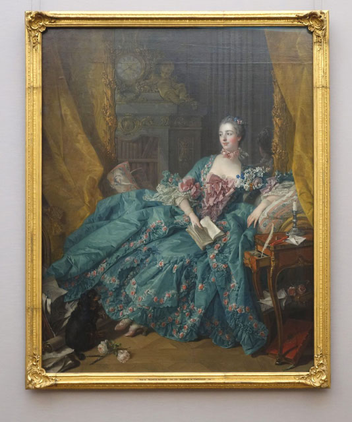
The Georgian Era, also called Rococo or Ancien Regime style, was an era of rapid change through the dawn of the Industrial Revolution, great social inequality but also artistic heights in a flourishing culture of art patronage.
France dominated court culture across Europe and Northern America with its luxury consumer industries. Porcelain, furniture,
and textiles from that country were bought by, or copied, in the rest of Europe and to the colonies. Louis XIV, the Sun King, had fostered the creation of these industries to strengthen the at
the time weak French economy, make the nobility spend their large fortunes and assign France a lasting place in fashion for centuries to come. The more austere and rigorous style of the Baroque
had given way to more decorative and refined designs in all arts - architecture, painting, sculpture, and decorative arts like furniture or dress. It is in France the time of Madame de
Pompadour's influence, of Marie Antoinette's adolescence and queendom. In England, the Georgian era is
usually considered to span the years from 1714 to 1837. It received its name from the succession of monarchs named George (Georges I, II, III and IV), although the relatively short reign of
William IV (1830-37) is also normally included.
The 18th century was a highly complex era and saw in its second half the Enlightenment, when literature like the works of
Jean Jacques Rousseau populated new ideas and ideals of natural living, education, and fewer restraints and caused a fascination for romanticised country living. Antiquarianism led to a
fascination for history and archaeology, especially the archaeology of the Greek and Roman civilisations - resulting in the neoclassical style. It is the century of American independence and in
France, the 1700s culminated in the Revolution and then the Directoire from which Napoleon would emerge as Emperor. This lavishly decorative Rococo style and later the neoclassical style were
picked up by the developing industrial production, such as by ceramics wizard Josiah Wedgwood and his impactful brand. This is the era of the steam engine as much as of the diamonds of the Affair
of the Necklace. In dress, it saw many changes as the slender Mantua styles of the early 1700s gave way to the fullness of the Robe à la Francaise and finally to the post-revolutionary
high-waisted, gauzy Empire/Regency style familiar from the time of Jane Austen.

The late Baroque Mantua style developed in the 1720s into the so-called Robe Volante. The Robe Volante, also called Contouche or Sacque, is a flowing one-piece dress that falls down loosely from the shoulders on front and back. The back is a so called sack-back, with large pleats. These pleats are referred to as Watteau pleats, after Antoine Watteau who in his paintings in the 1720s showed many women wearing this style. The Robe Volante is a dress with front closure. The opening is covered by the stomacher, a piece of usually embroidered or otherwise decorated fabric that is pinned onto the stays to cover up the opening. At the back underneath the pleats is lacing to hold the gown together. The skirts are shaped through paniers, hoop skirts that are tied around the waist and sit on either side of the hips to puff up the skirts. Fabrics in use were linen, silk, taffeta, atlas, damask, brocade, cotton and wool. From the Volante, the Robe à la Francaise developed over time.

The Robe à la Francaise evolved - also called Sack-Back due to the still present pleats in the back, adding great
fullness to the skirt and blowing like a sail when walking in a breeze. The Volante changed shape and the waist became defined while the skirt spread out sideways while flattening in the front
and back. This was made possible by the introduction of undergarments. Stays had been worn even under the loose Volante but hoop-skirts called paniers made from steel, whalebone
or reeds and fabric (see more below) were now worn under the skirt to give it the right shape.

The Francaise consisted of three pieces: the Manteau or Mantua (the mantle), the Jube (the skirt) and a triangle-shaped stomacher, often richly decorated. The Manteau and the Jube were usually of the same fabric and lavishly decorated with quillings, lace, bows, silk and fabric flowers, scalloped and pleated stripes, etc.. The neckline, usually very low, was decorated with lace or embroidery. At first, bows were only used to decorate the neckline but with time passing it became fashionable to adorn the whole stomacher with bows. Madame de Pompadour was obviously very fond of this fashion as she wears it in several paintings from the 1750s.
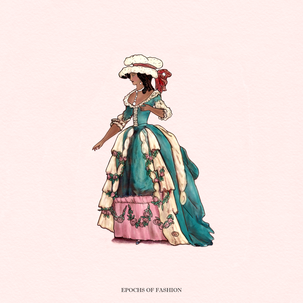
Although 18th century fashion consists of several layers, getting dressed was neither extremely difficult or very time-consuming. It has to be remembered that for daily private life not all the finery that is commonly associated with the era was actually worn.
Over the chemise (the under-dress), a relatively close-fitting and calf-long
underskirt can be tied around the waist. Its job is to protect the wearer's decency if a gust of wind lifts up the wide upper skirts. Over the chemise goes the pair of stays. Costume
historically speaking, corsets do not appear before the 19th century. In the earlier eras it was stays. They are laced
either in the front (for the less wealthy women as they have to lace it themselves) or in the back (for women who had a maidservant). The lacing is done in a spiral with just one cord which is
tied with a knot at the upper and lower end of the corset, rather than the cross-lacing used nowadays.
While tighly laced and ill-fitted stays do cause discomfort and shortness of breath, a good pair worn in a comfortably way does not. Stays were specifically made for that person and thus could provide a good fit. They were not worn necessarily to create a very small waist, but mainly to get that smooth silhouette the styles required and also to improve an upright posture. For women in physically demanding jobs like in the kitchen or as market sellers, stays provided good back and belly support. 18th century stays, made from buckram and whalebone, warmed up to body temperature during wear and are flexible enough not to restrict movement too much. You can bend down in stays, or run.
Importantly, not every woman tight-laced, in fact very few did. Like nowadays where some celebrities wear extreme shapewear or have plastic surgery, it is a few people
and not all of us. It was probably mainly among the very top of fashionable society that people tight-laced in the 1700s. For the majority of the population, stays were only hugging the
body and not constricting it. Therefore, tales of deformed organs are mainly urban myths. Many such reports came from medical professionals or members of the cleric who censured all kinds of
'frivolous' fashions and assumed negative effects on women's fertility and on their 'hysteric tempers'. As late as the later 19th century, medical practitioners wrote for example that the womb
could dislocate and fall out by wearing heeled shoes. Well-fitted stays made sure the dresses sat well, helped achieve the silhouette and improve posture. Reports to the contrary are usually
tinged with sexism. Clearly modern clothes give more freedom to slouch in front of the computer or on the couch for example, but stays were no torture devices.

The stays are followed by what shapes the skirt: pocket hoops (paniers) or different kinds of padded pillows. which are indeed used as pockets). Paniers come either as two seperate baskets or joined into a long hoopskirt. The paniers are hollow and used as pockets to store and carry items around. One or several underskirt(s) follow. They conceal and even out the contours of the pocket hoops and the cul de Paris so that the Jube falls nicely. Over that, the visible skirt, the floor-long Jube, finds its place. The skirts have about 20cm long slashes on both sides of the hip which allows one to put the hands into the pockets. The Manteau is the actual "dress" - a floor-long or shorter kind of mantle which is in the Francaise open in the front to show the stomacher underneath is put on. It is pinned to the bodice down the front and the gap it leaves is then concealed with the stomacher.
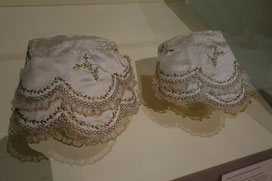
The tight sleeves, which were not sewn into the armhole but placed and fixed on top of it, were elbow-length. There, a folded up cuff sat, or great flounces of fine lace or delicate embroidered fabric called Engageantes.
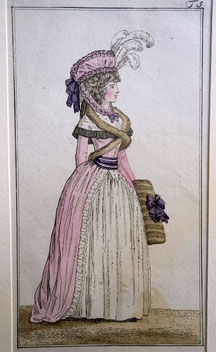
In England, the Robe à la Francaise received a makeover to form a new style: the
Robe à l'Anglaise. The Watteau
pleats are gone, so is the stomacher and the bodice ends pointed at the front and the back. As the bodice front is now cut in two pieces that meet in the middle front, they have to be cut on the
fabric bias so that the pieces have stretch and mould nice and flat around the torso without rippling.
Dresses with ruffled up skirts in the back are often immediately
referred to as Robes à la Polonaise. However, in a Polonaise there is a waist seam separating the bodice part from the skirt. A deceptively similar garment is the Robe à l´Anglaise
retroussée but there the front bodice goes seamlessly into the skirt. The name refers to the alleged inspiration from the clothes of Polish peasant women who tucked up their skirts to protect the
hems while working on the fields. The ruffled up skirt was held up either through drawstring channels so that you could pull up the skirts and tie a knot in the strings to keep it up, or through
loops of ribbons that lift the skirt or small loops that go around buttons at the waist seam. Therefore, sometimes fashion prints and paintings show the visible ribbons that fasten the
skirt.
Towards the later 18th
century the shape changed from the rectangular Francaise silhouette to a more round, full skirt shape. This was created through new padding options, such as the cul de Paris. This is three padded pillows on a waistband that when tied around the waist sit at either side of the hips and at the back.
The Split Rump consists of two large pillows/sacks filled with padding material or bits of cork . It puffs up the skirt on either side of the bottom and is
mainly used with the Polonaise/Robe à l'Anglaise retroussée.

When the Gaulle or Chemise à la Reine (the Queen's chemise)was first introduced to the public by Marie
Antoinette in her portrait by Elisabeth Vigée-Lebrun, it resulted in a scandal. People both condemned her for apparently wearing a shift and for introducing a style that might put France's silk
weavers out of work.
The Chemise à la Reine consisted of several layers of light muslin, belted with a colourful sash around the waist. Commonly, the colour was white or a pastel shade. Sleeves can reach just over the elbows or to the wrists and can have small flounces where they end. Likewise the round neckline is usually trimmed with one or two layers of flounces.

For travel and for horseback riding, a riding habit was worn: a jacket with short tails and an overlong skirt to drape down and veil the legs when sitting on horseback. Sometimes, riding habits were quilted. Often, they are modelled on male military and sporting dress.
The Brunswick was another type of dress for travel, or just informal everyday wear. Again it is made up of a skirt and (hooded) jacket. Both styles are long-sleeved for practicality, sometimes the shape of the engageantes in the Francaise and Anglaise are hinted at in Brunswicks by the addition of flounces onto the long sleeve above the elbow.
Do you wish to own or gift a piece of history? Now in my etsy-shop:
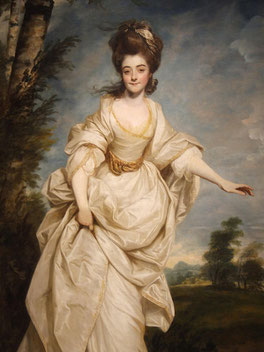
A popular kind of informal dress (worn inside the house, among the family) is a wrapping gown. The wrapping gown is worn with corset
and chemise underneath. Like modern wrapping dresses it is open in the front and wrapped around the waist. The fabric is softly coloured, light and flowing, the skirt is long and full. Although
for private environment, many women had themselves painted in a wrapping gown.
Foreign cultures brought to Western Europe by colonialism, especially the Middle East and Asia, were very popular in France. This
fascination with Orientalism was patronised by the likes of Madame de Pompadour who had herself painted à la turque. The colourful and flowing clothes (so different from the stiff French
court fashion), ornated belts, wide sleeves, pearl jewellery, coffee, turbans, baggy silk trousers - everything was studied with both fascination and moral judgment by the establishments. The
antique world was also influential on these currents for garments which did not require copious amounts of underpinnings. This is evident in the Portrait of a Young Woman as a Vestal Virgin
(sometimes identified as Madame de Pompadour) where the sitter wears a silk wrap dress.


Another informal garment is a pet-en-l'air jacket. This jacket has a sack back construction and was worn over a petticoat or the Jube. It looks just like a Robe à la Francaise with shortened skirt. It could be fastened with hooks and eyes (the stomacher is divided lengthwise), tied with ribbon or pinned to a corset with decorative lacing. The materials are the same as for the gowns. There is a painting in Upton House, 1740s, unknown artist, which depicts an unknown (but undoubtedly rich) Lady is clad in a blue pet-en-l'air probably made of silk and trimmed (or perhaps fully lined) with ermine fur.The Caraco was another type of jacket, fashionable in the 1760s. It is similar to the pet-en-l'air (which can be seen in my painting on the right hand side) but has no sack back. The back is tight-fitting like the one of a Robe à l'Anglaise.
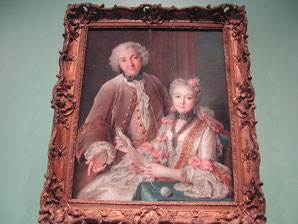
Accessories:
In the 17th century the folding fan came up. In the following time, fans reached a high degree of artistry. The parchment or silk was decorated with floral patterns, garden scenes or sceneries from the ancient Greek and Roman mythology.
For daily live beyond the courtly occasions, a light kerchief called Fichu was worn around the neck (usually white) and inserted into the neckline. This Fichu emphasised the bust while providing warmth and a degree of more propriety during daytime. Like nowadays, everyday clothes and evening wear differ.

Shoes:
In the Rococo era, shoes with heels and (very) pointed toes were worn. The Louis-heel, a heel that is wider at the top and base that in the middle, was characteristic for the Rococo era and has been famous ever since.
There was yet no difference in the making of a right and left shoe, the heel and soles were carved of wood. This may sound uncomfortable, but shoes were custom-made for those who did not rely on second-hand shoes. Therefore, they were exactly fitted to the foot and may even have been more comfortable than modern off-the-rack shoes.
There were mules, such as Madame de Pompadour wears in the accompanying image, as well as closed shoes which fastened with overlapping straps and buckles.
Receive The Epochs of Fashion Gazette - Dress and art history news to delight you!
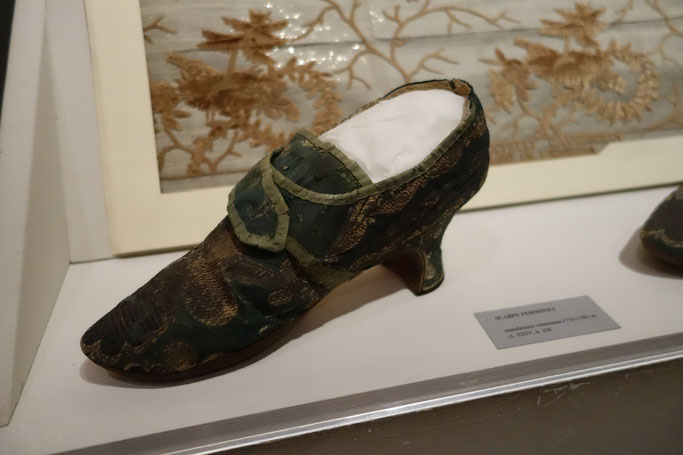
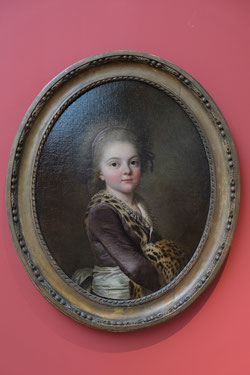
Beauty:
Contrary to the popular myth of stinking aristocrats in Versailles trying to cover up their lack of hygiene with extraordinary amounts of perfume, and having rats nesting in the hairdos, people washed themselves regularly.
In Versailles and in several other residences, bathing rooms can be found with large tubs. The body was also rubbed with perfumed towels and people did endeavour to keep their teeth clean and healthy. Unfortunately, toothpaste was for a short time made with sugar as the main ingredient which did not produce the wanted results. Linen underwear and bedsheets were changed very frequently and although common 18th century ideas of hygiene were not quite equal to ours today, they were not as rank and heavily perfumed as is the general stereotype.
A pale complexion with rosy cheeks and dark eyebrows was the ideal. There were face paints that included lead and other harmful chemicals but they were not the norm. Rouge was a normal feature of make-up, but for instance Georgiana Spencer-Cavendish, Duchess of Devonshire, and her daughter are said to have worn none. By making them appear natural and artless, this met good critics. For sleeping, the frames, cushions and finery were removed, the hair pinned up and covered with a coif.
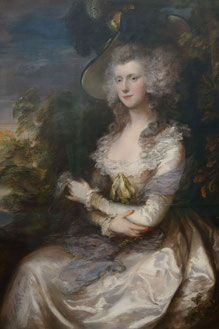
Hair:
At the beginning of the Rococo epoch the hair was worn relatively close to the head in updo hairstyles, outside the
house covered and not yet powdered or accreted by hair pieces as one was proud of the own (healthy and shiny) hair. In the late 1760s and 70s the coiffures became increasingly high. The
hair was pomaded, powdered and draped over wire frames, with the augmentation of false hair. Adding to that came everything from false flowers to bows and miniature paintings to pearls and
feathers among the court and upper class. In 1774, Marie Antoinette stunned the French court with her "pouf" (='cushion/pillow') hairstyle which is somewhat of an ancestor of the beehive
hairstyle of the 20th century.
In the later 1770s Georgiana Spencer-Cavendish, Duchess of Devonshire, astonished the fashion world with a 90cm (1yd) high hair tower adorned with jewels and e.g artificial fruit and birds. Consequently, riding in a carriage was only possible by sitting on the floor – very comfortable indeed. Another trend-set of hers was adding a huge ostrich-feather to her (high) coiffure that bobbed at every motion of the head.
Already in the end of the 1770s, however, the mounted-up coiffures became lower and were displaced by the so-called hedgehog hairstyle. This style is very voluminous around the head via many curls, especially to either side, with long curls hanging onto the shoulders and back. This style was worn with large coifs indoors and wide-brimmed hats outdoors. Paintings of Georgiana Cavendish, Duchess of Devonshire show her with that hairstyle and the film adaption of her life (“The Duchess”) flatters with quite accurate hairstyles and dresses. To the Chemise a la Reine (introduced in the 1780s) Marie Antoinette wore her hair curly with a big straw hat adorned with a light-blue ribbon and bow and ostrich-feathers. The high hairdos and the mob lasting until the 1790s disappeared and only left low coiffures, small curls and and braids behind.
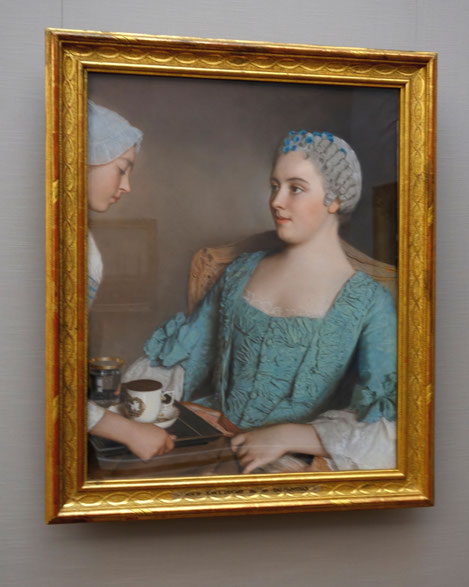
Jewellery:
As high-quality lace was as valuable as gemstones, it was also used as jewellery, worn as a choker around the neck. Pearl-necklaces and pearls earrings were in vogue, just as well as diamond jewellery in form of collars, earrings and bracelets (a set of two identical ones for each wrist). All in all, only a minimum of gemstone/diamond jewellery was worn around the neck – generally, the lace quill is adornment enough (with perhaps a small pearl-necklace). It was very popular to wear miniatures (portraits or the profile as relief) on necklaces and ribbons around the neck, on a pearl or ribbon bracelet (looks like a watch) and as a brooch attached to the bodice. Likewise, cameos were fashionable.
Patterns:
-
Laughing Moon Mercantile 18th C. Robe à l'Anglaise #182
- Burda 2447 (dress A: passes for à la Polonaise, B: à la Francaise)
- Simplicity 3635 (French Rococo underwear including corset and hoop-skirt)
- Simplicity 3637 (Robe à la Francaise)
- Simplicity 4092 (dresses; looks like the one might be inspired by Pirates of the Caribbean :-)) [I have sewn the dress. Making it was sometimes quite difficult so it is nothing for inexperienced sewers and you need a very lot of fabric too, but it is worth everything. It became amazing and I love it. MY DRESSES]
- Simplicity 8578 (Robe à la Francaise)
- Nehelenia Patterns np20 1790s Jacket Pattern
- Nehelenia Patterns np21 1790s Redingote Pattern
- Please note that this list claims no completeness and does not operate as advertisement. It was merely composed for informative purposes. Furthermore, no valuation of the patterns is implied or intended -
© Epochs of Fashion








